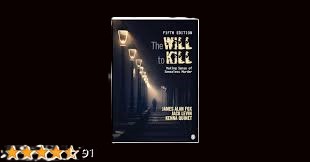Introduction
The Will To Kill: Making Sense of Senseless Murder 5th Edition is a book that brings together academic rigor and real-world case analysis to help students understand some of the most perplexing homicide cases. In this review, I walk through its updates, content, and the value it offers to those studying criminology and criminal justice. From all-in-one theoretical developments to detailed discussions on current trends in homicide laws, this book has a lot to offer without resorting to sensationalism. Whether you are new to the topic or have been studying homicide for years, this edition promises a fresh perspective enriched with modern research and the latest statistical data.
From its in-depth exploration of domestic and workplace murders to its analysis of cult-related and hate crimes, the book sheds light on many forms of homicide. Throughout its chapters, The Will To Kill invites readers to get involved in thought-provoking discussions that combine academic theory with case studies drawn from the most recent incidents. The purpose is simple: to educate students and professionals about what drives these senseless acts and how the criminal justice system responds to them.
This review not only examines the main themes of the book but also contextualizes the evolving methodologies used to understand homicide. By drawing on both historical contexts and modern innovations, the narrative provides readers with a multi-layered view of how laws and investigative techniques have transformed over time. The detailed narratives and statistical backing are designed to bridge the gap between textbook theory and the real challenges faced by law enforcement and policymakers.
In addition, the book offers several practical scenarios and reflective questions that help the reader build a broader understanding of the complexities of modern homicide cases. The journey through its chapters reveals many subtle relationships between evidence, theory, and the multifaceted nature of human behavior. As you read on, you will notice that the text is structured in a way that gradually builds your analytical skills while also providing significant insights into current trends and debates in the field.

Book Overview and New Edition Features
The Fifth Edition of The Will To Kill is more than just an update in name. It represents an extensive revision that incorporates up-to-date research and the latest data on homicide trends and patterns. The authors have meticulously reviewed current homicide laws, integrating popular and emerging theories that attempt to explain why murder—an act that appears senseless on the surface—follows certain patterns over time.
This edition is structured to help students build a solid theoretical foundation. Early chapters introduce key concepts surrounding homicide definitions and laws, then progressively expand into deeper examinations of different homicide scenarios such as domestic violence, workplace killings, hate crimes, and even acts committed by juveniles. Every case study is presented not to shock or sensationalize, but to provide context that aids in understanding the nuanced ways society responds to violent behavior.
The updated content reflects major legislative changes, recent controversies, and evolving Supreme Court decisions that affect how homicide is prosecuted. New research findings and boosted statistical presentations make this edition a valuable asset for both classroom discussion and independent study. The authors have taken extra care to ensure that each update is not only factually correct but also presented in a manner that is accessible without losing academic rigor.
To further elaborate on the transformative nature of this new edition, the authors include interviews with law enforcement professionals and legal scholars. These firsthand accounts add an extra layer of authenticity and provide real-world context that deepens the reader’s understanding of the issues at hand. The narrative pierces through technical jargon, aiming instead to clarify and simplify, which makes it an indispensable tool for both students and practitioners.
Additional sections in the book explore case studies that were previously only mentioned in passing. The expanded discussions allow readers to appreciate the evolution of forensic techniques, as well as changes in the legal and social interpretations of homicide. Moreover, integrated timelines and infographics enrich the reading experience by visually mapping out significant milestones in the development of homicide investigation protocols.
Book Details and Background Information
Title: The Will To Kill: Making Sense of Senseless Murder
Edition: 5th Edition
Authors: A team of renowned criminologists and legal experts
Publisher: SAGE Publishing
Price Range: Varies by market. Please check your local listings for the most recent details.
This section of the review details the core bibliographic information that frames the text. What is notable is not just the pedigree of the authors involved, but also the thoughtful approach they have taken in compiling and analyzing data from recent homicide cases. Their cooperative effort ensures that the book marries the theoretical with the empirical, providing students a well-rounded narrative on the subject.
One of the aspects that makes this edition stand out is its commitment to bridging the gap between academic research and criminal justice practice. Detailed explorations of how improved forensic analysis and surveillance technologies have transformed police investigations are interwoven with discussions that examine legislative adjustments and prosecutorial strategies. Each section of the book has been enhanced with real-world examples to ensure that readers understand the practical implications as well as the theoretical underpinnings of modern homicide investigations.
This carefully curated background not only provides factual information but also creates a dialogue between past and present analytical methods. The authors have striven to cover every angle, ensuring that both the minutiae and the broader trends are fully explored. This layered approach makes the book a crucial resource for anyone serious about understanding the catalysts and consequences of violent crime.
Updated Research and Modern Case Studies
With every new edition comes new research, and The Will To Kill does not disappoint on this front. The Fifth Edition introduces extensive updates that reflect the latest statistical data on homicide patterns, trends, and repeat offenders. The content has been revised to account for recent changes in demographic trends in violent crimes, incorporating insights that help illustrate how economic and social shifts influence crimes of passion and premeditated acts alike.
Several new illustrative cases boost the narrative by offering detailed examinations into homicides that captured public attention and influenced policymakers. Cases involving mass shootings, domestic disputes that escalated into violence, and even hate-motivated crimes are presented in a manner that is factual and educational. The authors have painstakingly selected cases that represent a range of circumstances, ensuring that the text covers a spectrum of scenarios and provides robust analytical insights.
Beyond the numbers, the book offers extended commentary on each case, exploring the psychological, social, and legal dimensions that underlie each incident. One section, for instance, focuses on how economic downturns correlate with spikes in certain types of violent crimes, providing both statistical backing and anecdotal evidence. Other sections offer deep examinations of serial homicide cases that shed light on behavioral patterns that have long puzzled investigators. These expanded discussions aim to equip readers not only with knowledge but also with the analytical tools necessary for forming their own interpretations of the data.
The narrative also includes reflective sidebars that offer context about the evolution of forensic methods over the last two decades. These additional insights are invaluable for comprehending how incremental improvements in technology and methodology have led to significant changes in law enforcement practices. Each case study is accompanied by comprehensive timelines and diagrams that map out the progression of the investigation, making the text both informative and engaging.
In-Depth Analysis of Homicide Patterns and Legal Frameworks
This section takes a closer look at how the book breaks down the trends observed in homicide cases over time. Through thorough statistical analysis, the text explores various dimensions of homicide, including but not limited to:
- Domestic Homicide: Instances stemming from domestic violence, marital disputes, and familial conflicts.
- Workplace Homicide: Detailed reviews of cases where conflicts within a professional setting escalated into deadly encounters.
- Cult and Hate Killings: Analyses of crimes driven by extremist ideologies and hate-fueled motivations.
- Juvenile Offenses: An exploration of cases involving younger offenders, raising questions about environmental and developmental influences.
- Serial Homicide: A study into the patterns identified among individuals who commit multiple murders, offering insights into unusual behavioral cycles.
Each category is presented with equal importance. The authors do not treat these cases as isolated incidents; instead, they are woven into a narrative that illustrates the evolution of homicide laws and the complex networks of causality that have developed over centuries. This systematic breakdown is particularly useful for students who are developing theories on the causes and consequences of violent behavior.
Furthermore, the discussion extends to various legal frameworks, including examinations of court rulings that have shaped modern interpretations of homicide laws. Landmark cases and legislative adjustments are discussed at length, providing readers with a contextual background that is essential for understanding current legal strategies in prosecuting violent crimes.
The narrative is enriched by side-by-side comparisons of past legal standards and their modern iterations. Such comparisons help the reader appreciate the gradual transformation of legal norms and enforcement practices. Through detailed charts and legal commentary, the book outlines how precedent cases have influenced current policies, making this section a critical focal point for understanding modern criminal jurisprudence.
Theoretical Frameworks and Criminological Perspectives
The early chapters of The Will To Kill set the stage for a deep examination into criminological theories designed to explain homicide. The text introduces both classical and contemporary theories in a logical sequence that allows students to build a robust analytical framework. Some of the theories covered include:
- Biological and Psychological Theories: Assessing how inherent traits and mental health factors may predispose individuals to violent behavior.
- Social Learning Theories: Exploring the influence of social environment, peer pressure, and cultural norms on behavior.
- Strain Theory: Investigating the roles economic hardships and social inequalities play in pushing individuals toward violence.
- Labeling Theory: Examining the impact of societal labels and stigmatization on personal actions and subsequent behavior.
The text does an excellent job of inviting critical analysis. Students not only learn about the different theories but are also encouraged to evaluate their merits and limitations by comparing them against detailed case studies. For instance, one chapter places side by side a psychodynamic perspective and social learning frameworks to assess which might better explain a particularly perplexing case of workplace homicide. This comparative approach is instrumental in teaching readers that no single theory can fully encapsulate the multifaceted nature of homicide.
Additional content in this section expands on interdisciplinary approaches, drawing from sociology, psychology, and legal studies to illustrate how overlapping factors converge to produce violent outcomes. The authors include detailed annotations and discussion questions at the end of each sub-section, prompting readers to further consider alternative viewpoints and the dynamic interplay between theory and practice.
This segment also features interviews with experts in criminology and forensic psychology, whose insights help distill complex theoretical constructs into more practical interpretations. Their commentary provides a bridge between academic concepts and real-world application, ensuring the reader can appreciate the nuanced perspectives that shape modern theories of crime and punishment.
Forensic Innovations and Technological Advances
One of the standout aspects of the Fifth Edition is its dedicated discussion on advancements in forensic technology and the consequential impact on homicide investigations. Historically, solving murder cases heavily depended on witness testimonies and circumstantial evidence. However, with rapid strides in technology, methods such as DNA testing, computer-aided investigations, and advanced surveillance systems have revolutionized the field.
The book carefully documents how these innovations have aided law enforcement agencies in not only cracking cases once considered unsolvable but also in attaining much higher accuracy in determining guilt or innocence. Several chapters are devoted to explaining how modern forensic techniques are applied practically, including:
- The evolution of DNA analysis, which now permits rapid testing and yields remarkably reliable outcomes.
- Computer-assisted case management systems that collate vast amounts of data to spot patterns across seemingly unconnected crime scenes.
- Advancements in surveillance technology that provide real-time monitoring as well as comprehensive review of historical footage.
- The integration of artificial intelligence in forensic investigations, which speeds up data analysis and enhances accuracy.
These innovations are not presented merely as supplements but are seamlessly integrated into the overarching narrative. The text provides thoughtful commentary on both the benefits and the challenges these technologies introduce, including issues related to privacy and ethical implications. Detailed case examples illustrate how modern forensic tools have accelerated case resolutions while also sparking new debates on the balance between security and individual rights.
The discussion also ventures into the future of forensic technology by highlighting emerging trends and potential legal reforms needed to accommodate rapid technological progress. Readers are encouraged to critically assess how these advancements might reshape both investigative practices and the broader legal landscape in the years to come.
Furthermore, long-form interviews with forensic experts and technologists add depth to the narrative, making this section a robust resource for anyone interested in the intersection of technology and criminal justice. Their experiences underscore the transformative power of these technologies and invite readers to imagine how future innovations could further revolutionize the field.
Illustrative Case Studies and Real-World Applications
The Will To Kill: Making Sense of Senseless Murder is filled with case studies that are meticulously curated to illustrate the theoretical points discussed in earlier chapters. These real-world examples span from high-profile cases that garnered widespread media attention to lesser-known incidents that offer unique perspectives into unusual homicide patterns.
Each case study is presented in a clear, straightforward manner with detailed narratives covering the following aspects:
- Preliminary investigations and the methods used in collecting crucial evidence.
- The role of modern forensic technology in uncovering hidden facts.
- An analysis of the perpetrator’s background, including potential motives and psychological profiles.
- The legal proceedings from arrest through to indictment and trial outcomes.
- The broader repercussions on public policy and legislative adjustments following the case.
For example, one case study carefully tracks a hate-motivated homicide from its early investigative stages through to courtroom drama and final sentencing. The detailed analysis not only demystifies the complex process behind solving such crimes but also provides a template for discussing broader societal implications. Other case studies demonstrate how breakthroughs in forensic techniques have breathed new life into cold cases, thus reinforcing the critical role of technology in modern criminal investigations.
The case studies are supplemented with expanded background information, including interviews with investigators and legal experts who revisit these incidents years later. Their reflections offer a layered understanding of the evolving methods used in homicide investigations, providing insights into both the science and the human elements behind these cases.
An additional section in this part of the book features interactive timelines and detailed maps that help the reader visualize the progression of investigations. The inclusion of these visual aids ensures that written content is well supported by graphical representations, thereby enriching the learning experience. These illustrative tools make the case studies not only engaging but also serve as valuable reference points for academic discussion.

Educational Value and Pedagogical Approach
One of the primary goals of The Will To Kill is educational—designed to encourage critical thinking and analytical skills among students of criminology and criminal justice. The book is written in an engaging style that aims to make complex theories and dense statistical data accessible. The authors successfully balance factual research with rich, illustrative case studies that help demystify the subject matter.
Key educational strategies employed in the text include an early introduction to core definitions and legal parameters, which lays a solid groundwork for more elaborate theoretical explorations later on. Readers are walked through a progressive layering of complexity, beginning with simple overviews and evolving into in-depth, multi-faceted analyses that challenge conventional wisdom.
Other strategies include thought-provoking discussion prompts and reflective questions at the end of each section. These questions are designed to stimulate further inquiry and ensure that readers not only absorb the information but also apply it to case scenarios. By fostering an interactive learning environment, the book becomes a dynamic educational tool that serves both classroom instruction and independent study.
Moreover, supplementary online materials and interactive modules accompany the text, allowing readers to test their analytical skills with quizzes and practical case simulations. This integrated approach ensures that the learning experience is holistic, melding theoretical knowledge with real-world applications. The pedagogical techniques extend beyond rote memorization and encourage genuine engagement with the serious subject of homicide.
Additional commentaries by experienced educators and professionals further enrich this section. Their insights help to bridge the gap between abstract theory and everyday practice, reinforcing the book’s stature as an indispensable resource for anyone looking to bolster their understanding of criminal justice and forensic science.
Discussion of Contemporary Issues and Future Trends
The Fifth Edition does not shy away from contemporary issues that influence both homicide trends and legal responses to violent crimes. Recent debates surrounding mass shootings, hate-motivated crimes, and even the controversial role of juvenile offenders in serious violent incidents are given considerable attention. The text examines how shifting societal norms, legislative changes, and technological innovations converge to shape both the frequency and the nature of homicide today.
Particular attention is paid to the impact of gun rights debates and recent Supreme Court decisions on homicide rates. Detailed analysis of policy shifts reveals how crimes are reclassified and prosecuted under evolving legal frameworks. Furthermore, the text discusses advancements in digital surveillance and computer-aided forensic investigations, highlighting both the benefits and the ethical dilemmas these technologies introduce.
To provide further depth, the book includes forward-looking essays by experts who speculate on the future of criminal justice. These essays offer predictions on how emerging trends may continue to affect homicide investigations, legal proceedings, and even public policy. The authors encourage readers to critically assess these predictions, thereby fostering a more dynamic and engaged discourse about the future of law enforcement and judicial practices.
This holistic discussion is further supported by extensive statistical data, case study comparisons, and detailed commentary on recent legislative reforms. The inclusion of multiple viewpoints ensures that the reader gains a well-rounded understanding of the ongoing transformations within the field of criminal justice. This section ultimately serves as both a current snapshot and a roadmap for future inquiry.
In expanding upon these discussions, the authors also explore international perspectives on homicide, comparing practices in different legal systems. These comparative analyses provide an added dimension to the conversation, making it clear that lessons learned in one country can often have implications on a global scale. The diverse range of perspectives showcased in this section is particularly beneficial for readers who wish to engage in broader debates about justice and reform.
Critical Reflections and Comparative Analysis
In addition to presenting thorough research and detailed case studies, The Will To Kill offers critical reflections on its own arguments. The authors candidly address the potential limitations of certain theories and confront the ongoing debates within criminology head-on. This self-critical approach forces readers to consider questions such as which theories most effectively explain different types of homicide and why certain perspectives might be more applicable in specific circumstances.
The comparative analysis in the book places side by side earlier editions and other seminal works in the field, highlighting both similarities and key differences in approach. Through detailed comparisons, the authors draw enlightening parallels between historical and modern methodologies. For example, an in-depth look at cold case investigations reveals how incremental technological improvements have reshaped investigative tactics over time.
This section is particularly engaging as it not only questions established ideas but also challenges the reader to think critically about alternative interpretations. Extended commentary and reflective prompts allow for a deeper exploration of how cultural, economic, and social factors intersect to produce violent outcomes. The analysis is enriched through visual data representations and comparative charts that provide an additional layer of clarity.
The inclusion of reflective essays from experts in both law enforcement and academia further bolsters the critical foundation of this section. Their viewpoints provide an external validation of the analyses presented and encourage readers to consider the broader implications of these studies on future research and policy formulation.
Final Thoughts on the Book’s Contribution to Homicide Scholarship
The Will To Kill: Making Sense of Senseless Murder 5th Edition is a notable addition to criminology and criminal justice literature. Its careful blend of empirical data, robust theoretical foundations, and detailed case analyses provides an all-in-one overview of homicide in modern society. This edition stands out for its commitment not to sensationalize violence but to educate readers about the multiple, interwoven factors that lead to these tragic events.
The book’s clear and engaging style makes it suitable for use in the classroom as well as for individual study. It informs and challenges its readers simultaneously, prompting them to question the conventional wisdom surrounding violent crime. By incorporating modern forensic technologies, up-to-date legal debates, and a diverse array of case studies, the book offers a well-rounded perspective that is both academically rigorous and practically relevant.
Educators will find the text a valuable asset, loaded with discussion prompts, detailed analyses, and a wealth of updated research. Its impact extends beyond academic analysis, influencing how future criminal justice professionals approach homicide investigations and policy decisions. The book is not merely a textbook; it is a comprehensive guide to understanding the underlying dynamics of violent crime.
Moreover, the final chapters of the book delve into reflective and philosophical discussions on the nature of violence, urging readers to consider broader societal implications. These sections challenge the reader to explore not only the data but also the human stories behind every case. In doing so, it reinforces the idea that meaningful understanding requires a multidimensional approach—a combination of hard facts, human experience, and critical reflection.
For those considering adding The Will To Kill to their academic libraries, know that this work represents a significant step forward in understanding homicide. With each revision, the authors reaffirm their commitment to reflecting current research and practice, thus ensuring that the book remains a living document—one that continues to evolve in response to new challenges and technological innovations.
While the content is vast, the book succeeds by simplifying the complex without sacrificing detail. It invites readers to look beyond surface-level data and appreciate the intricate interplay of legal, psychological, and socio-economic factors. Ultimately, it makes a compelling case that education and ongoing critical discussion are essential to addressing violent crime effectively.
In wrapping up these reflections, it is clear that The Will To Kill stands as a testament to the power of informed inquiry. Its detailed analysis and rich case studies not only inform but also inspire a deeper commitment to justice and reform. For anyone passionate about understanding the darker facets of human behavior without leaning on sensationalism, this book is a must-read.
As a final note, readers are encouraged to reflect on the layered narratives and engage with the text repeatedly, as each reading offers new insights and a clearer understanding of the multifaceted nature of homicide.
Concluding Reflections
While it might be easy to critique any academic text for its omissions, The Will To Kill: Making Sense of Senseless Murder 5th Edition fully embraces its role as both educator and catalyst for discussion. It does not claim to have all the answers. Instead, it provides a framework through which critical questions about homicide can be explored. This humility, combined with a dense compendium of updated research, serves to pull readers into serious contemplation and active discussion.
The book’s thoughtful organization, which begins with basic definitions before gradually moving into complex analyses, demonstrates a clear pedagogical intent. It reassures readers that the journey to understanding homicide is progressive, starting with foundational knowledge and moving toward more intricate sociological, psychological, and legal terrains.
For educators, this text is a treasure trove of data, analysis, and discussion prompts. For students, it offers a structured pathway to build on foundational knowledge and then question pre-established notions about violence and retribution. And for researchers and practitioners, it provides not only a snapshot of current trends but also a roadmap for future inquiry.
In closing, The Will To Kill 5th Edition is a comprehensive resource that deepens our understanding of this complex subject. Its well-crafted blend of updated research, thoughtful case analyses, and accessible language makes it a standout contribution in the field of homicide studies. Those interested in gaining insights into the factors behind senseless acts of violence will find this book both informative and inspiring.
If you have questions or find certain sections challenging, you can always revisit earlier chapters for a refresher on foundational concepts. This ongoing process of review underscores the book’s design as not just a reference, but a lifelong companion in the study of human behavior and justice.
The concluding pages offer more than just a summary of facts and figures. They provide a call to action—a reminder that understanding and preventing violence starts with informed discussion and critical analysis. The book challenges its readers to think, learn, and ultimately contribute to positive changes within the justice system.
This text is not just about analyzing homicide statistics. It is also about understanding the human stories behind each tragedy. It is not just a study of legal precedents—it is a deep exploration of societal values and the challenges we face as a community. Each case, each discussion, and each analysis is a stepping stone towards a more informed and empathetic perspective on crime and punishment.
Every year, as forensic science and psychological research progress, new insights emerge that improve our understanding of homicides. The Fifth Edition harnesses these advances and provides readers with a progressive narrative that paves the way for future breakthroughs in both academic research and practical law enforcement. Grounded in fresh data and updated legal contexts, the book offers a story of continuous improvement and innovation.
For readers ready to jump into The Will To Kill, know that its pages offer a wealth of hard facts, nuanced theories, and a broad overview of how modern society grapples with the most senseless crime—murder. This is not just a simple narrative; it is a call to get involved in rethinking and reforming how we understand and handle violent crime.
Every example detailed in the book invites further debate and inquiry. It encourages you not only to absorb information but also to critically analyze the causes and consequences of each violent act. Thus, by the time you finish reading, you have embarked on an intellectual adventure that is as enlightening as it is challenging.
In a field where every new discovery has the potential to reshape established practices, The Will To Kill offers vital insights. Its mix of detailed case studies, legal analysis, and thoughtful commentary instills a sense of responsibility in its readers—to not only learn from the past but also to actively participate in forging a safer and more just future.
This review barely scratches the surface of what this all-in-one text has to offer. I hope that as you explore its pages, you will join the ongoing conversation about justice, inquiry, and reform. Your engagement with these ideas is a crucial step toward creating meaningful change in both the academic realm and society at large.
Acknowledging the Complexity of Senseless Murder
It is very important to recognize that while the subject of homicide can be profoundly unsettling, The Will To Kill offers a compassionate and scholarly approach to untangling the causes and effects of violent crime. Its balanced narrative ensures that the focus remains on education and understanding rather than on the exploitation of tragedy.
The authors carefully portray the multifaceted nature of homicide, providing readers from all walks of life a glimpse into the interplay between law enforcement techniques, societal pressures, and individual psychology. The text stands as a robust academic resource, reinforcing the idea that to truly grasp any form of violence, one must consider the complete picture—the convergence of personal circumstances, societal demands, and historical context.
As you reflect on the insights presented in this edition, consider how they might not only inform your academic pursuits but also broaden your perspective on justice and human behavior. Through deliberate analysis, detailed case studies, and a steadfast commitment to the latest research, The Will To Kill becomes an essential text for anyone determined to make sense of senseless acts of violence.
In academic circles, few books manage to balance depth with clarity as well as this one. Its significant contribution lies in how it simplifies the complex without trivializing the harsh realities of homicide. It encourages readers to appreciate that behind every statistic lies a human story—one that is shaped by legal, psychological, and social forces interwoven together over time.
Thank you for taking the time to explore this review. If you have additional questions or thoughts about the content and its broader implications on future policy and research, do not hesitate to get involved in the ensuing discussion. Your thoughtful participation is what drives the evolution of the field and ensures that our collective understanding of homicide continues to progress.
Invitation to Reflect and Engage
This review of The Will To Kill: Making Sense of Senseless Murder 5th Edition serves both as an informative guide and as an invitation to further reflection. It calls upon students, researchers, and practitioners alike to engage deeply with the complexities of homicide and to contribute positively to the conversations about justice and reform.
As you consider the key insights and analyses laid out in the text, remember that each case study and theoretical discussion is not simply a recitation of events but a stepping stone towards a richer understanding of our shared human condition. It is by meticulously examining these details that we can formulate more effective strategies to prevent future tragedies.
The academic journey can be challenging at times; however, resources like this book are designed to be faithful companions. By grounding discussions in hard evidence and robust critical analysis, it constantly urges us to push the boundaries of our understanding and strive for a more just society.
In the end, The Will To Kill stands as a testament to the power of thorough research, compassionate inquiry, and the relentless pursuit of knowledge even in the face of daunting subjects. Its pages challenge you to not only learn from the past but also to picture a future where informed decisions lead to positive change. This book is more than a study—it is an invitation to contribute to a better, more informed approach to some of society’s most demanding challenges.
May this extended exploration inspire you to keep questioning, keep learning, and above all, to keep working toward a brighter understanding of the world we inhabit. Your engagement is the very first step on a long road to lasting change.
For those ready to further explore the intricate dynamics of homicide, The Will To Kill: Making Sense of Senseless Murder 5th Edition awaits your attention. Instead of simply stating that it is an academic text, consider the layered insights it offers—each page not only imparts vital information but also encourages you to critically evaluate how these lessons apply to real-world scenarios. This book is not solely about numbers and case files; it is about unraveling the human stories interwoven with every act of violence.
Every year, forensic science and psychological research give us new tools to better understand how and why homicides occur. With each new discovery, the landscape of criminal justice is reshaped. By integrating these fresh insights, the Fifth Edition provides a narrative that is both current and forward-thinking, offering a roadmap for future innovations in academic research and practical law enforcement.
Curious minds will find that every case study, legal analysis, and theoretical discussion within its pages sparks further debate and inquiry. It not only presents the facts but also poses new questions about the causes of violence and the best ways to address them. As you finish reading, you will not only have expanded your knowledge but will be better prepared to contribute to ongoing debates about justice and reform.
This review and the book itself barely scratch the surface of the subject matter. Nevertheless, they provide a detailed glimpse into what makes this Fifth Edition a landmark contribution to the fields of criminology and criminal justice. Your intellectual adventure into the complexities of homicide is only just beginning, and the insights gained from this text will undoubtedly serve as a guide in both your academic and professional endeavors.
May you find the journey through its pages as enlightening as it is challenging, and may it inspire you to continually seek deeper understanding and more meaningful solutions to the problems of violence in our society. Some of the links on this website are affiliate links, meaning, at no additional cost to you, I may earn a commission if you click through and make a purchase. Please note that I only recommend products or services that I personally use and believe will be beneficial for my readers link to buy book>>https://amzn.to/4b6KgUX








